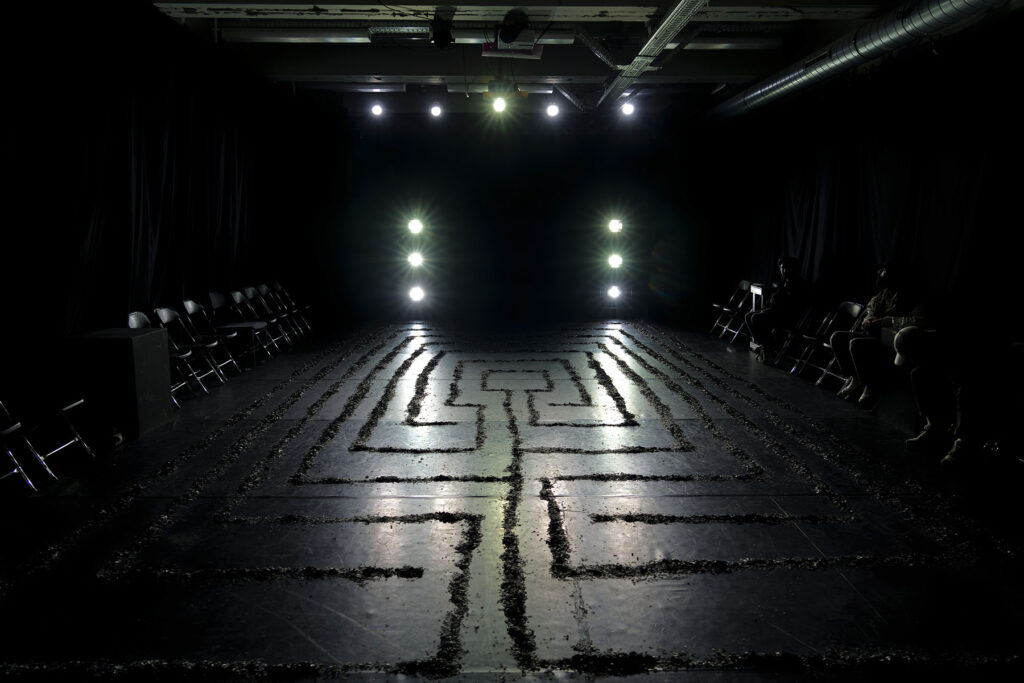The myth: In ancient Crete, the Minotaur—part man, part bull—dwelt near King Minos’ palace in a vast underground labyrinth designed by Daedalus. There, the king’s prisoners would meet their fate, trapped in the bewildering maze with the raging, towering hybrid, until Greek hero Theseus slew the beast and escaped through ingenious use of a string he had wended behind him upon entering.
boycow, or The Minotaur, or 10 Acts (1-5), or Bullshit: (Thu/17-Sat/19, Counterpulse, SF): “a thought form, a choreography, an incantation, a litany, word-labyrinth made of social contracts, coconut oil, confetti, greek myth and playing herself, as herself, the THEATER. A singular dance solo performed simultaneously by two bodies in separate spaces. The audience members are invited to move between the rooms, leaving one performer, coming to the other performer, coming to other audiences. We could say ‘queering the myth of the Minotaur.’ We could say ‘a choreography of language, according to labyrinthine logics.’ We could say ‘Wait, just wait. Please Stay.'”
boycow dancers Cornelius (who choreographed) and Gabriele Christian are also known in the community as singular drag performers—VivvyAnne ForeverMore and Eartha Cunt, respectively—and found their way to boycow through the maze of their performance careers, via a thread of fascination with labyrinths and the Minotaur myth. The show has some surprising roots and coincidental conceptions.
“I started doing research on the Minotaur and the labyrinth myth in 2015, outside of other projects.” Cornelius told me. “I had a residency at Headlands Center for the Arts, and became invested in the idea of someday making a Minotaur piece. I started grad school and saw the opportunity to work on it, and then the pandemic hit in the middle of that, and I was like, ‘Welp!’ That got put on pause.
“The other idea that came at that time was creating a solo that happened on two bodies. I didn’t know what the material was going to be, but I know I wanted to do the structure. When things had settled down a bit, I approached Gabriele with the idea of that structure, and I also said I was working on something about the Minotaur—and then they said they were also working on the Minotaur in their own work. It was like this freaky connection that happened, but we were on the same path.”

“The idea for me was still pretty incipient at the time,” Gabriele said. “It was a fresh thought. I was part of a festival called Ecotones that had me working in the Sibley Volcanic Regional Preserve in the East Bay. There were labyrinths all over the site there, and I gravitated to the idea of making a dance piece that moved through all the labyrinths—there was a bull mask, but it was, like, very minimal Minotaur involvement at that time. [Laughs]
“My friend Asha and I did a one day thing out there. This was around the time COVID was happening; labyrinths seemed to be showing up everywhere: in some of my film work, or when I started traveling to local labyrinths like the one at Land’s End, Bernal Hill, Grace Cathedral, where I did a performance. They were appearing constantly, I just didn’t know what to do with them. So when Cornelius approached me, I was like, ‘Oh, great!’ This is a way for all this to have a deeper purpose. It was great timing. Uncanny.”
Artistic interpretations of the labyrinth are nothing new, of course, and examples like the Grace Cathedral labyrinth are bone fide tourist attractions—but that’s part of what drew Cornelius in.
“I like playing with played-out ideas, something that’s a bit failed or flawed or even considered corny or silly,” they said. “The labyrinth has become a cliche of itself in a lot of ways, they have this whole spiritual aspect and meditative usage, their meaning has been talked about and talked about. So I didn’t feel I had to explain anything or have any new ideas around it, which actually made me feel comfortable in doing something. I didn’t have to be clever and make some giant statement like ‘this is about temporality and queerness and heteronormativity blah blah blah.
“The Minotaur itself as a metaphor is quite obvious as well: It’s a ‘dangerous other.’ It’s a hybrid, which you could say is multi-species, multiracial, whatever. It’s born out of wedlock, so it’s ‘born with sin.’ It has all of these easy interpretations, especially ‘oh it’s queer.’ It’s almost a tragic character in that way. It’s too easy! But for me, what really drew me to the labyrinth was the writer Rebecca Solnit. In one of her books she has a short piece about a sculpture she visited that was a labyrinth, and she wrote so beautifully about it that it inspired me to think about the choreographic possibilities.”
A book also drew Gabriele into the choreographic labyrinth—with a thread running back to one of the key figures in San Francisco contemporary dance, the late, great Kathleen Hemmensdorf. “I inherited a book from Kathleen’s library called Four Times Through the Labyrinth—it’s four lectures about a public art work that Olaf Nicolai installed in Paris in 1998. I remember being obsessed with this book when I first got it in 2022. It relates the idea of the labyrinth to the city, to urban life and migration, and it makes these large scale claims about the implications of this. Like there’s one way in and one way out, but this illusion exists of it being a way more complicated path.
“This was so aligned with what I was thinking about—with my own work around faith, but around cruising also, which has been another pathway. The labyrinth exists in dark basements and Berlin clubs, bathhouses… it’s embedded in the infrastructure of these places that I have frequented, or still frequent. Even the way we just spend our days follows a unicursal path, wending its way back to the home space. As a performer, I don’t think you realize some of the patterns you’re following until you’re forced to confront them.”

The idea of creating one’s own labyrinth by being able to move between the two rooms and simultaneous performances has roots in club culture. “Drag practice informs a lot of my choreography,” Cornelius said. “And during a drag show at a club you can go to the bar or the bathroom or outside to smoke or whatever during a performances. Just like, you can leave, and it isn’t considered a reflection on the performer—or it can be, but not necessarily. [Laughs.]
“It’s just part of the night. You can do this with visual art, too. Look at it for a while and then walk away. One of the things that happens in Europe during a performance that’s kind of shocking if you’re from the US is people just get up and leave if they want. Just go and maybe come back, right in the middle. So the concept ties into that.
“The idea of two performers taking on the same material is also found in drag,” Cornelius continued. “You go to Britney Spears night, and you have an idea of how someone might do a song, and then they start that song, and kind of compete with the expectation you have in your head, from seeing other performances going back maybe decades ago. And then another performer comes on and rewrites things again. The difference here is that we are doing it at the same time and in different spaces, and it’s something you’ve never seen before, so it’s kind of an endless rewrite of itself.”
Going back to cruising, the promo photos for boycow are a bit sexy in a fetishistic way, with both performers dressed in leather thongs and glinting, thigh-high buckled stilettos, heavy padlocks dangling from huge chains around their necks, like cowbells, and both holding buckets more reminiscent of the Greek myth of the Hercules cleaning the Augean stables than the Minoan labyrinth. (Hey, even Minotaurs leave cow pies behind.)
“We don’t want to give away anything,” said Cornelius. “But we talked for a long time about the costuming and the lighting, and there’s definitely a sense of Eros and desire that comes into things. And those are milk buckets, by the way, which are just as crazy. [Laughs.] We’re not trying to get horny on people, but there’s so many metaphorical associations and linguistic in-jokes that happen in this context that you can find yourself lost in that maze, too.”
boycow, or The Minotaur, or 10 Acts (1-5), or Bullshit runs Thu/17-Sat/19 at Counterpulse, SF. More info here.





